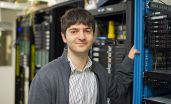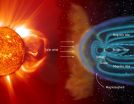(Press-News.org) In the decade since the genome was sequenced in 2003, scientists and doctors have struggled to answer an all-consuming question: Which DNA mutations cause disease?
A new computational technique developed at the University of Toronto may now be able to tell us.
A Canadian research team led by professor Brendan Frey has developed the first method for 'ranking' genetic mutations based on how living cells 'read' DNA, revealing how likely any given alteration is to cause disease. They used their method to discover unexpected genetic determinants of autism, hereditary cancers and spinal muscular atrophy, a leading genetic cause of infant mortality.
Their findings appear in today's issue of the leading journal Science.
Think of the human genome as a mysterious text, made up of three billion letters. "Over the past decade, a huge amount of effort has been invested into searching for mutations in the genome that cause disease, without a rational approach to understanding why they cause disease," says Frey, also a senior fellow at the Canadian Institute for Advanced Research. "This is because scientists didn't have the means to understand the text of the genome and how mutations in it can change the meaning of that text." Biologist Eric Lander of the Massachusetts Institute of Technology captured this puzzle in his famous quote: "Genome. Bought the book. Hard to read."
What was Frey's approach? We know that certain sections of the text, called exons, describe the proteins that are the building blocks of all living cells. What wasn't appreciated until recently is that other sections, called introns, contain instructions for how to cut and paste exons together, determining which proteins will be produced. This 'splicing' process is a crucial step in the cell's process of converting DNA into proteins, and its disruption is known to contribute to many diseases.
Most research into the genetic roots of disease has focused on mutations within exons, but increasingly scientists are finding that diseases can't be explained by these mutations. Frey's team took a completely different approach, examining changes to text that provides instructions for splicing, most of which is in introns.
Frey's team used a new technology called 'deep learning' to teach a computer system to scan a piece of DNA, read the genetic instructions that specify how to splice together sections that code for proteins, and determine which proteins will be produced.
Unlike other machine learning methods, deep learning can make sense of incredibly complex relationships, such as those found in living systems in biology and medicine. "The success of our project relied crucially on using the latest deep learning methods to analyze the most advanced experimental biology data," says Frey, whose team included members from University of Toronto's Faculty of Applied Science & Engineering, Faculty of Medicine and the Terrence Donnelly Centre for Cellular and Biomolecular Research, as well as Microsoft Research and the Cold Spring Harbor Laboratory. "My collaborators and our graduate students and postdoctoral fellows are world-leading experts in these areas."
Once they had taught their system how to read the text of the genome, Frey's team used it to search for mutations that cause splicing to go wrong. They found that their method correctly predicted 94 percent of the genetic culprits behind well-studied diseases such as spinal muscular atrophy and colorectal cancer, but more importantly, made accurate predictions for mutations that had never been seen before.
They then launched a huge effort to tackle a condition with complex genetic underpinnings: autism spectrum disorder. "With autism there are only a few dozen genes definitely known to be involved and these account for a small proportion of individuals with this condition," says Frey.
In collaboration with Dr. Stephen Scherer, senior scientist and director of The Centre for Applied Genomics at SickKids and the University of Toronto McLaughlin Centre, Frey's team compared mutations discovered in the whole genome sequences of children with autism, but not in controls. Following the traditional approach of studying protein-coding regions, they found no differences. However, when they used their deep learning system to rank mutations according to how much they change splicing, surprising patterns appeared.
"When we ranked mutations using our method, striking patterns emerged, revealing 39 novel genes having a potential role in autism susceptibility," Frey says.
And autism is just the beginning--this mutation indexing method is ready to be applied to any number of diseases, and even non-disease traits that differ between individuals.
Dr. Juan Valcárcel Juárez, a researcher with the Center for Genomic Regulation in Barcelona, Spain, who was not involved in this research, says: "In a way it is like having a language translator: it allows you to understand another language, even if full command of that language will require that you also study the underlying grammar. The work provides important information for personalized medicine, clearly a key component of future therapies."
INFORMATION:
Brendan Frey is a professor in The Edward S. Rogers Sr. Department of Electrical & Computer Engineering, with cross-appointments to the Donnelly Centre for Cellular and Biomolecular Research, Department of Molecular Genetics, Department of Computer Science, and McLaughlin Centre at University of Toronto. He is a senior fellow of the Canadian Institute for Advanced Research, and a member of the Technical Advisory Board of Microsoft Research.
This research was supported by The Canadian Institute for Advanced Research (CIFAR); The Canadian Institutes of Health Research (CIHR); The Natural Sciences and Engineering Research Council of Canada (NSERC); The McLaughlin Centre; Autism Speaks; Genome Canada; Autism Training Program.
The majority of RNA expression differences between individuals have no connection to the abundance of a corresponding protein, report scientists from the University of Chicago and Stanford University in Science on Dec. 18. The findings point to a yet-unidentified cellular mechanism that regulates gene expression and suggest studies that rely only on RNA measurements to characterize gene function require further analysis.
"The chief assumption for studies of RNA differences is that they ultimately reflect differences in an end product, which is protein," said senior study ...
HANOVER, N.H. - Human cells are protected by a largely impenetrable molecular membrane, but researchers have built the first artificial transporter protein that carries individual atoms across membranes, opening the possibility of engineering a new class of smart molecules with applications in fields as wide ranging as nanotechnology and medicine.
The study, which appears Friday, Dec. 19, in the journal Science, is a milestone in designing and understanding membrane proteins. A PDF is available upon request. The study was conducted by researchers from Dartmouth College, ...
A study of the way malaria parasites behave when they live in human red blood cells has revealed that they can rapidly change the proteins on the surface of their host cells during the course of a single infection in order to hide from the immune system.
The findings, which overturn previous thinking about the Plasmodium falciparum parasite's lifecycle, could explain why so many attempts to create an effective vaccine have failed and how the parasites are able to survive in the human body for such long periods of time.
In the study, Plasmodium falciparum parasites were ...
Scientists and engineers have built a computer model that has uncovered disease-causing mutations in large regions of the genome that previously could not be explored. Their method seeks out mutations that cause changes in 'gene splicing,' and has revealed unexpected genetic determinants of autism, colon cancer and spinal muscular atrophy.
CIFAR Senior Fellow Brendan Frey (University of Toronto) is the lead author on a paper describing this work, which appears in the Dec. 18 edition of Science Express. The paper was co-authored by CIFAR senior fellows Timothy Hughes (University ...
The evolution of trichromatic color vision in humans occurred by first switching from the ability to detect UV light to blue light (between 80-30 MYA) and then by adding green-sensitivity (between 45-30 MYA) to the preexisting red-sensitivity in the vertebrate ancestor. The detailed molecular and functional changes of the human color vision have been revealed by Shozo Yokoyama et al. Emory University and is published in the journal PLOS Genetics.
The molecular basis of functional differentiation is a fundamental question in biology. To fully appreciate how these changes ...
CAMBRIDGE, MA -- For decades, neuroscientists have been trying to design computer networks that can mimic visual skills such as recognizing objects, which the human brain does very accurately and quickly.
Until now, no computer model has been able to match the primate brain at visual object recognition during a brief glance. However, a new study from MIT neuroscientists has found that one of the latest generation of these so-called "deep neural networks" matches the primate brain.
Because these networks are based on neuroscientists' current understanding of how the ...
A University of Southampton researcher has helped solve a long standing space mystery - the origin of the 'theta aurora'.
Auroras are the most visible manifestation of the Sun's effect on Earth. They are seen as colourful displays in the night sky, known as the Northern or Southern Lights. They are caused by the solar wind, a stream of plasma - electrically charged atomic particles - carrying its own magnetic field, interacting with the earth's magnetic field.
Normally, the main region for this impressive display is the 'auroral oval', which lies at around 65-70 degrees ...
PROVIDENCE, R.I. - Where you live affects the type of bacteria that cause bloodstream infections, according to researchers at Rhode Island Hospital and an international team of investigators. The closer you live to the equator, the greater the likelihood of a bloodstream infection caused by a group of bacteria called Gram-negative bacteria, which thrive in warm and moist environments, compared to another group of bacteria referred to as Gram-positive bacteria. The study also found that the proportion of a country's GDP spent on health care impacted the type of bacteria ...
DALLAS - Dec. 18, 2014 - Retroviruses are best known for causing contagious scourges such as AIDS, or more sporadically, cancer.
But researchers at UT Southwestern Medical Center and Karolinska Institutet in Stockholm, Sweden, found that endogenous retroviruses (ERV) also play a critical role in the body's immune defense against common bacterial and viral pathogens.
"Most scientists have become used to the view that retroviruses are generally harmful," said Nobel Laureate Dr. Bruce Beutler, Professor and Director of UT Southwestern's Center for the Genetics of Host ...
Primates visually recognise and determine the category of an object even at a brief glance, and to date, this behaviour has been unmatched by artificial systems. A study publishing this week in PLOS Computational Biology has found that the latest artificial "deep neural network" performs as well as the primate brain at object recognition.
Charles Cadieu and colleagues from MIT measured the brain's object recognition ability by implanting arrays of electrodes in the inferior temporal cortex of macaques. This allowed the researchers to see the neural representation -- the ...

